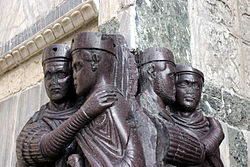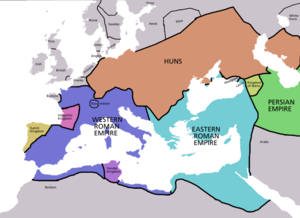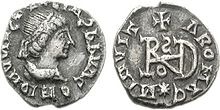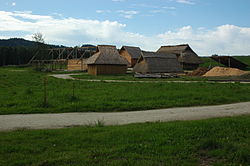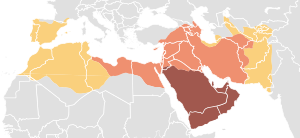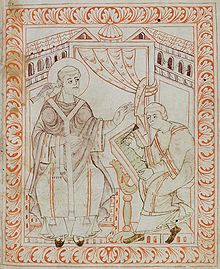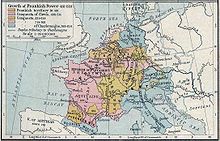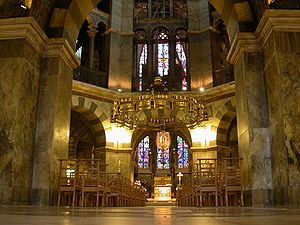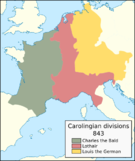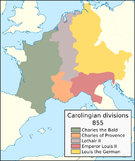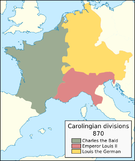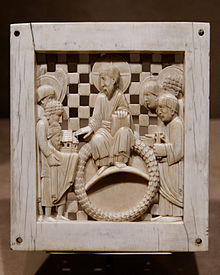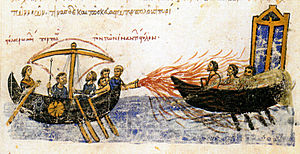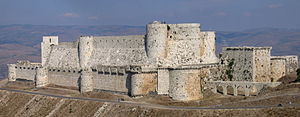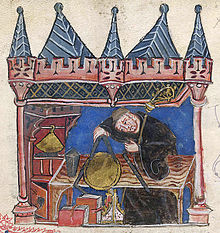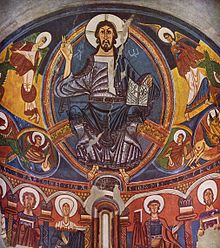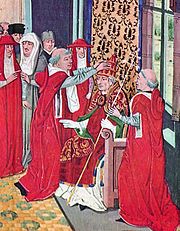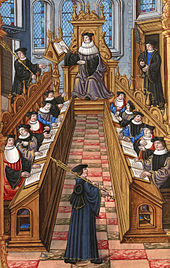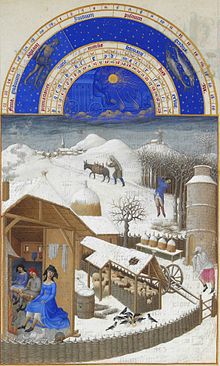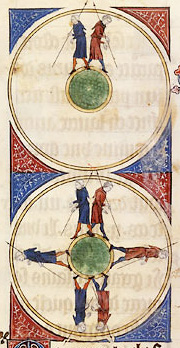
Middle Ages
Background to the schools Wikipedia
This selection is made for schools by a children's charity read more. Child sponsorship helps children one by one http://www.sponsor-a-child.org.uk/.
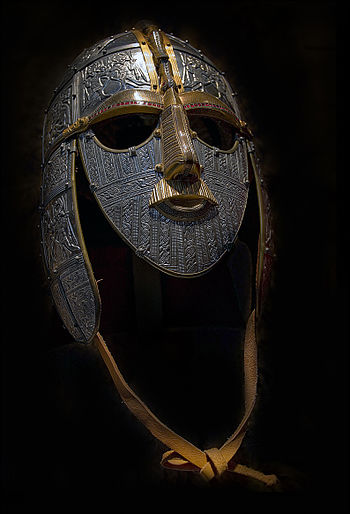
The Middle Ages or Medieval period is a stretch of European history that lasted from the 5th until the 15th centuries. It began with the collapse of the Western Roman Empire, and was followed by the Renaissance and the Age of Discovery. The Middle Ages is the middle period of the traditional division of Western history into Classical, Medieval, and Modern periods. The period is subdivided into the Early Middle Ages, the High Middle Ages, and the Late Middle Ages.
In the Early Middle Ages, depopulation, deurbanization, and barbarian invasions, which began in Late Antiquity, continued. The barbarian invaders formed new kingdoms in the remains of the Western Roman Empire. In the 7th century North Africa and the Middle East, once part of the Eastern Roman Empire (the Byzantine Empire), became an Islamic Empire after conquest by Muhammad's successors. Although there were substantial changes in society and political structures, the break with Antiquity was not complete. The still sizeable Byzantine Empire survived and remained a major power. The empire's law code, the Code of Justinian, was widely admired. In the West, most kingdoms incorporated extant Roman institutions, while monasteries were founded as Christianity expanded in western Europe. The Franks, under the Carolingian dynasty, established an empire covering much of western Europe; the Carolingian Empire endured until the 9th century, when it succumbed to the pressures of invasion — the Vikings from the north; the Magyars from the east, and the Saracens from the south.
During the High Middle Ages, which began after AD 1000, the population of Europe increased greatly as technological and agricultural innovations allowed trade to flourish and crop yields to increase. Manorialism — the organization of peasants into villages that owed rent and labor services to the nobles; and feudalism — the political structure whereby knights and lower-status nobles owed military service to their overlords, in return for the right to rent from lands and manors - were two of the ways society was organized in the High Middle Ages. The Crusades, first preached in 1095, were military attempts, by western European Christians, to regain control of the Middle Eastern Holy Land from the Muslims. Kings became the heads of centralized nation states, reducing crime and violence but making the ideal of a unified Christendom more distant. Intellectual life was marked by scholasticism, a philosophy which emphasized joining faith to reason, and by the founding of universities. The philosophy of Thomas Aquinas, the paintings of Giotto, the poetry of Dante and Chaucer, the travels of Marco Polo, and the architecture of Gothic cathedrals such as Chartres are among the outstanding achievements of this period.
The Late Middle Ages were marked by difficulties and calamities, such as famine, plague, and war, which much diminished the population of western Europe; in the four years from 1347 through 1350, the Black Death killed approximately a third of the European population. Controversy, heresy, and schism within the Church paralleled the warfare between states, the civil war, and peasant revolts occurring in the kingdoms. Cultural and technological developments transformed European society, concluding the Late Middle Ages and beginning the Early Modern period.
Etymology and periodization
The Middle Ages is one of the three major periods in the most enduring scheme for analyzing European history: classical civilization, or Antiquity, the Middle Ages, and the modern period.
Development of the concept
Medieval writers divided history into periods such as the " Six Ages" or the " Four Empires" and considered their time period to be the last before the end of the world. In the 1330s, the humanist and poet Petrarch referred to pre-Christian times as antiqua (or "ancient") and to the Christian period as nova (or "new"). Leonardo Bruni was the first historian to use tripartite periodization in his History of the Florentine People (1442). Bruni and later historians argued that Italy had recovered since Petrarch's time, and therefore added a third period to Petrarch's two. The "Middle Ages" first appears in Latin in 1469 as media tempestas or "middle season". In early usage, there were many variants, including medium aevum, or "middle age", first recorded in 1604, and media scecula, or "middle ages", first recorded in 1625. Tripartite periodization became standard after the German historian Christoph Cellarius published Universal History Divided into an Ancient, Medieval, and New Period in 1683. English is the only major language that retains a plural form of the term.
Start and end dates
The most commonly given start date for the Middle Ages is 476, first used by Bruni. For Europe as a whole, 1500 is often considered to be the end of the Middle Ages, but there is no universally agreed upon end date; depending on the context, events such as Christopher Columbus's first voyage to the Americas in 1492, conquest of Constantinople by the Turks in 1453, or the Protestant Reformation in 1517 are sometimes used. In contrast, English historians often use the Battle of Bosworth Field in 1485 to mark the end of the period. For Spain, dates commonly used are the death of King Ferdinand II in 1516, the death of Queen Isabella I of Castile in 1504, or the conquest of Granada in 1492.
Historians from Romance-speaking countries tend to divide the Middle Ages into two parts: an earlier "High" and later "Low" period. English-speaking historians, following their German counterparts, generally subdivide the Middle Ages into three intervals: "Early", "High" and "Late". Belgian historian Henri Pirenne and Dutch historian Johan Huizinga popularized the following subdivisions in the early 20th century: the Early Middle Ages from 476 to 1000, the High Middle Ages from 1000 to 1300, and the Late Middle Ages from 1300 to 1453. In the 19th century, the entire Middle Ages were often referred to as the "Dark Ages", but with the creation of these subdivisions use of this term was restricted to the Early Middle Ages, at least among historians.
Timeline

Later Roman Empire
The Roman Empire reached its greatest territorial extent during the 2nd century AD, with the following two centuries witnessing the slow decline of Roman control over its outlying territories. Economic issues, including inflation, and external pressures on the frontiers combined to make the 3rd century politically unstable, with a number of emperors coming to the throne only to be rapidly replaced by new usurpers. Military expenses increased steadily during the 3rd century, mainly in response to the need to defend against the renewed war with Sassanid Persia, which began in the middle of the 3rd century. The army doubled in size and various reforms in composition resulted in a new emphasis on cavalry and smaller units instead of the infantry legion as the main tactical unit. The need for revenue led to increased taxes and a decline in numbers of the curial landowning class, and decreasing numbers of them willing to shoulder the burdens of holding office in their native towns. More bureaucrats were needed in the central administration to deal with the needs of the army, which led to complaints from civilians that there were more tax-collectors in the empire than tax-payers.
The Emperor Diocletian (r. 284–305) split the empire into separately administered eastern and western halves in 286; however, the empire was not considered divided by its inhabitants or rulers, as legal and administrative promulgations in one division were considered valid in the other. In 330, after a period of civil war, Constantine the Great (r. 306–337) refounded the city of Byzantium as the newly renamed eastern capital, Constantinople. Diocletian's reforms strengthened the governmental bureaucracy, reformed taxation, and strengthened the army, which bought the empire time but did not completely resolve the problems it was facing: excessive taxation, a declining birthrate, and pressures on its frontiers among others. Civil war between rival emperors became common in the middle of the 4th century, diverting soldiers from the empire's frontier forces and allowing barbarians to encroach. But for much of the 4th century, Roman society had reached a new, stable form that differed from the earlier classical period in a number of significant ways - a widening gulf between the rich and poor as well as a decline in the vitality of the smaller towns. Another change was the conversion of the empire to Christianity, which occurred in a gradual process that lasted from the 2nd through the 5th centuries.
In 376, the Ostrogoths, fleeing from the Huns, received permission from the Roman emperor Valens (r. 364–378) to settle in the Roman province of Thracia. The settlement did not go smoothly, and when Roman officials mishandled the situation, the Ostrogoths began to raid and plunder. Valens, attempting to put down the disorder, was killed in battle with the Ostrogoths at the Battle of Adrianople on 9 August 378. Besides the barbarian threat from the north, internal divisions within the empire, especially within the Christian Church, caused troubles. In 400, the Visigoths invaded the Western Roman Empire and, although briefly forced back from Italy, in 410 they were able to sack the city of Rome. While the Visigoths were invading, in 406 the Alans, Vandals, and Suevi crossed into Gaul; over the next three years they spread across Gaul and in 409 crossed the Pyrenees Mountains into modern-day Spain. Other groups of barbarians took part in the movements of peoples in this time period. The Franks, Alemanni, and the Burgundians eventually all ended up in northern Gaul while the Angles, Saxons, and Jutes settled in Britain. In the 430s the Huns began invading the empire; their king Attila led invasions into the Balkans in 442 and 447, into Gaul in 451, and into Italy in 452. The Hunnic threat remained until Attila's death in 453, when the Hunnic confederation he led fell apart. All of these invasions by the varied tribes totally rearranged the political and demographic face of what had been the Western Roman Empire.
By the end of the 5th century the western section of the empire was divided into smaller political units, ruled by the tribes that had invaded in the early part of the century. The last emperor of the west, Romulus Augustulus, was deposed in 476, which has led that year to be traditionally cited as the end of the Western Roman Empire. The Eastern Roman Empire, often referred to as the "Byzantine Empire" after the fall of its western counterpart, had little ability to assert control over the lost western territories. Even though Byzantine emperors maintained a claim over the territory, and no barbarian king in the west dared to elevate himself to the position of Emperor of the West, Byzantine control of most of the West could not be sustained; the reconquest of the Italian peninsula and Mediterranean periphery by Justinian was the sole, and temporary, exception.
Early Middle Ages
New societies
Although the political structure in western Europe had changed, the divide is not as extensive as some historians have claimed. Although the activity of the barbarians is usually described as "invasions", they were not just military expeditions but were migrations of entire peoples into the Empire. Such movements were aided by the refusal of the western Roman elites to either support the army or pay the taxes that would have allowed the military to suppress the migration. The emperors of the 5th century were often controlled by military strongmen such as Stilicho (d. 408), Aspar (d. 471), Ricimer (d. 472), or Gundobad (d. 516), and when the line of western emperors ceased, many of the kings who replaced them were from the same background as those military strongmen. Intermarriage between the new kings and the Roman elites was common. This led to a fusion of the Roman culture with the customs of the invading tribes, including the popular assemblies which allowed free male tribal members more say in political matters. Material artifacts left by the Romans and the invaders are often similar, with tribal items often being obviously modeled on Roman objects. Similarly, much of the intellectual culture of the new kingdoms was directly based on Roman intellectual traditions. An important difference was the gradual loss of tax revenue by the new polities. Many of the new political entities no longer provided their armies with tax revenues, instead allocating land or rents. This meant there was less need for large tax revenues and so the taxation systems decayed. Warfare was common between and within the kingdoms. Slavery declined as the supply declined, and society became more rural.
Between the 5th and 8th centuries, new peoples and powerful individuals filled the political void left by Roman centralized government. The Ostrogoths settled in Italy in the late 5th century under Theodoric (d. 526) and set up a kingdom marked by its cooperation between the Italians and the Ostrogoths, at least until the last years of Theodoric's reign. The Burgundians settled in Gaul, and after an earlier kingdom was destroyed by the Huns in 436, formed a new kingdom in the 440s between today's Geneva and Lyon. This grew to be a powerful kingdom in the late 5th and early 6th centuries. In northern Gaul, the Franks and Britons set up small kingdoms. The Frankish kingdom was centered in northeastern Gaul and the first king of whom much is known is Childeric (d. 481). Under Childeric's son Clovis (r. 509–511), the Frankish kingdom expanded and converted to Christianity. The Britons, related to the natives of Britannia - modern-day Great Britain, settled in what is now Brittany. Other kingdoms were established by the Visigoths in Spain, the Suevi in northwestern Spain, and the Vandals in North Africa. In the 6th century, the Lombards settled in northern Italy, replacing the Ostrogothic kingdom with a grouping of duchies that occasionally selected a king to rule over all of them. By the late 6th century this arrangement had been replaced by a permanent monarchy.
With the invasions came new ethnic groups into parts of Europe, but the settlement was uneven, with some regions such as Spain having a larger settlement of new peoples than other places. Gaul's settlement was uneven, with the barbarians settling much heavier in the northeast than in the southwest. Slavonic peoples settled in central and eastern Europe and into the Balkan Peninsula. The settlement of peoples was accompanied by changes in languages. The Latin of the Western Roman Empire was gradually replaced by languages based on but distinct from Latin, which are collectively known as romance languages. These changes from Latin to the new languages took many centuries and went through a number of stages. Greek remained the language of the Byzantine Empire, but the migrations of the Slavs added Slavonic languages to Eastern Europe.
Byzantine survival
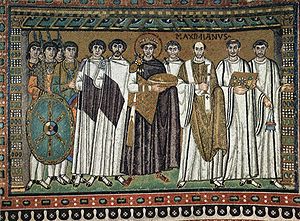
As western Europe witnessed the formation of new kingdoms, the eastern section of the Roman Empire remained intact and experienced an economic revival that lasted into the early 7th century. There were fewer invasions of the eastern section of the Empire, with the majority occurring in the Balkans. Peace with Persia, the traditional enemy of Rome, lasted throughout most of the 5th century. The Eastern Empire was marked by closer relations between the political state and Christian church, with doctrinal matters assuming an importance in eastern politics that they did not have in western Europe. Legal developments included the codification of Roman law, with the first effort - the Theodosian Code - completed in 438. Under the emperor Justinian (r. 527–565), a further compilation took place - the Corpus Juris Civilis. Justinian also oversaw the construction of the Hagia Sophia in Constantinople and the reconquest of North Africa from the Vandals and Italy from the Ostrogoths, under Belisarius. The conquest of Italy was not complete, as a deadly outbreak of plague in 542 led to the rest of Justinian's reign concentrating on defensive measures rather than further conquests. At the emperor's death, the Byzantines had control of most of Italy, North Africa, and a small foothold in southern Spain. Justinian's reconquests have often been criticized for overextending his realm and setting the stage for the Muslim conquests. But many of the difficulties faced by Justinian's successors were due not just to overtaxation for Justinian's wars, but to the essentially civilian nature of the empire which made raising troops difficult.
In the Eastern Empire the slow infiltration of the Balkans by the Slavs added a further complication. Although it began as a small invasion, by the late 540s Slavic tribes were in Thrace and Illyrium, and had defeated an imperial army near Adrianople in 551. In the 560s the Avars began to expand from their base on the north bank of the Danube River; by the end of the 6th century they were the dominant power in Central Europe and routinely able to force the eastern emperors to give tribute. They remained a strong power until 796. Further complications were the involvement of the emperor Maurice (r. 582–602) in Persian politics when he intervened in a succession dispute. This led to a period of peace but when Maurice was overthrown in turn, the Persians invaded and during the reign of the emperor Heraclius (r. 610–641) managed to control large chunks of the Empire, including Egypt, Syria, and Asia Minor. Heraclius was eventually able to secure a peace treaty with the Persians in 628 that restored the earlier boundaries of the Empire.
Western society
Society in Western Europe changed with the new rulers. Some of the Roman elite families died out while others became more involved with Church than secular affairs. The older values of Latin scholarship and education mostly disappeared, and while literacy remained important, it became a practical skill rather than a sign of elite status. In the 4th century, Jerome dreamed that God rebuked him for spending more time reading Cicero than the Bible. By the 6th century, Gregory of Tours had a similar dream, but instead of being chastised for reading Cicero, he was chastised for learning shorthand. By the late 6th century, the principal means of religious instruction in the Church ceased to be the book and was replaced with music and art. Most intellectual efforts went towards imitating classical scholarship, but some original works were created, along with now-lost oral compositions. The writings of Sidonius Apollinaris, Cassiodorus, and Boethius were typical of the age.
With laymen, a similar change took place, with the aristocratic culture focusing on great feasts held in halls. Clothing for the elites was richly embellished with jewels and gold. Lords and kings supported entourages of fighters who formed the backbone of the military forces of the time. Family ties within the elites were important, as were the virtues of loyalty, courage, and honour. These ties led to the prevalence of the feud in aristocratic society, examples of which included those related by Gregory of Tours that took place in Merovingian Gaul. Most feuds seem to have ended quickly with the payment of some sort of compensation usually ending the feud. Women took part in aristocratic society mainly in terms of their functions as wives or mothers of men, with the role of mother of a ruler being especially prominent in Merovingian Gaul. In Anglo-Saxon society, the lack of many child rulers meant less role for women as queen mothers but this was compensated for by the increased role played by abbesses of monasteries. Only in Italy does it appear that women were considered as always under the protection and control of some male relative.
Peasant society is much less documented than the nobility. Most of the surviving information available to historians comes from archaeology; few detailed written records documenting peasant life remain from before the 9th century. Most the descriptions of the lower classes come from either law codes or writers from the upper classes. Landholding patterns in the West were not uniform, with some areas having greatly fragmented landholding patterns and other areas with a pattern of large, contiguous blocks of land being the norm. These differences allowed for a wide variety of peasant societies with some being dominated by aristocratic landholders and others having a great deal of autonomy. Land settlement also varied greatly. Some peasants lived in large settlements that numbered as many as 700 inhabitants. Others lived in small groups of a few families and still others lived on isolated farms spread over the countryside. There were also areas where the pattern was a mix of two or more of those systems. Unlike in the late Roman period, there was no sharp break between the legal status of the free peasant and the aristocrat, and it was possible for a free peasant's family to rise into the aristocracy over a number of generations through military service to a powerful lord.
Roman city life and culture changed greatly in the early Middle Ages. Although Italian cities remained inhabited places, they contracted greatly in size. Rome shrank from a population of hundreds of thousands to around 30,000 by the end of the 6th century. Roman temples were converted into Christian churches and the city walls remained in use. In Northern Europe, cities also shrank, while the public monuments and other public buildings were raided for building materials. The establishment of new kingdoms often meant some growth for the towns chosen as capitals.
Rise of Islam
Religious beliefs in the Eastern Empire and Persia were in flux during the late 6th and early 7th centuries. Judaism was an active proselytising faith, and at least one Arab political leader converted to Judaism. Christianity had active missions competing with the Persian's Zoroastrianism in seeking converts, especially among residents of the Arabian Peninsula. All strands came together with emergence of Islam in Arabia during the lifetime of Muhammad. After Muhammad's death in 632, Islamic forces went on to conquer much of the Eastern Empire as well as Persia, starting with Syria in 634–635 and later as far as Egypt in 640–641, Persia between 637 and 642, North Africa in the later 7th century and the Iberian Peninsula in 711. By 714, Islamic forces controlled much of the peninsula, a region they called Al-Andalus.
The Islamic conquests only slowed in the middle of the 8th century. The first check was the defeat of Muslim forces at the Battle of Poitiers in 732, which led to the reconquest of southern France by the Franks. But the main reason for the ebbing of Islamic conquests in Europe was the overthrow of the Umayyad dynasty and its replacement by the Abbasid dynasty. The Abbasids moved their capital to Baghdad and their interests were more concerned with the Middle East than Europe. The Abbasids lost control of sections of the Muslim lands - with Umayyad descendants taking over the Iberian Peninsula along with the Aghlabids controlling North Africa and the Tulunids ruling Egypt. By the middle of the 8th century, new trading patterns were emerging in the Mediterranean, with trade between the Franks and the Arabs replacing the old Roman patterns of trade. Franks traded timber, furs, swords and slaves to the Arabs in return for silks and other fabrics, spices, and precious metals.
Trade and economy
The barbarian invasions of the 4th and 5th centuries caused disruption in trade networks around the Mediterranean. African trade goods disappear from the archeological record slowly, first disappearing from the interior of Europe and by the 7th century they are usually only found in a few cities such as Rome or Naples. By the end of the 7th century, under the impact of the Muslim conquests, African products are no longer found in Western Europe, and have been mostly replaced by local products. The replacement of trade goods with local products was a trend throughout the old Roman lands that happened in the Early Middle Ages. This was especially marked in the lands that did not lie on the Mediterranean, such as northern Gaul or Britain. What non-local goods that appear in the archeological record are usually luxury goods. In the northern parts of Europe, not only were the trade networks local, but those goods that were produced were simple, with little use of pottery or other complex products. Around the Mediterranean Sea, however, pottery remained prevalent and appears to have been traded over medium range networks and not just produced locally.
Church and monasticism
Christianity was a major unifying factor between Eastern and western Europe before the Arab conquests, but the conquest of North Africa sundered maritime connections between those areas. Increasingly the Byzantine Church, which became the Orthodox Church, differed in language, practices, and liturgy from the western Church, which became the Catholic Church. The eastern church used Greek instead of the western Latin. Theological and political differences emerged, and by the early and middle 8th century issues such as iconoclasm, clerical marriage, and state control of the church had widened enough that the cultural and religious differences were greater than the similarities. The formal break came in 1054, when the papacy and the patriarchy of Constantinople clashed over papal supremacy and mutually excommunicated each other, which led to the division of Christianity into two churches – the Roman Catholic Church and the Eastern Orthodox Church.
The ecclesiastical structure of the Roman Empire survived the barbarian invasions in the west mostly intact, but the papacy was little regarded, with few of the western bishops looking to the bishop of Rome for religious or political leadership. Many of the popes prior to 750 were in any case more concerned with Byzantine affairs and eastern theological concerns. The register, or archived copies of the letters, of Pope Gregory the Great, (pope 590–604) survives, and of those more than 850 letters, the vast majority were concerned with affairs in Italy or Constantinople. The only part of western Europe where the papacy had influence was Britain, where Gregory had sent the Gregorian mission in 597 to convert the Anglo-Saxons to Christianity. Other missionary efforts were led by the Irish, who between the 5th and the 7th centuries were the most active missionaries in western Europe, with missionaries going first to England and Scotland and then later onto the continent. Irish missionaries, under such monks as Columba (d. 597) and Columbanus (d. 615), not only founded monasteries but also taught in Latin and Greek and were active authors of secular and religious works.
The Early Middle Ages witnessed the rise of monasticism in the West. The shape of European monasticism was determined by traditions and ideas that originated in the deserts of Egypt and Syria. Most European monasteries were of the type that focuses on community experience of the spiritual life, called cenobitism, which was pioneered by Pachomius (d. 348) in the 4th century. Monastic ideals spread from Egypt to western Europe in the 5th and 6th centuries through hagiographical literature such as the Life of Anthony. Benedict of Nursia (d. 547) wrote the Benedictine Rule for Western monasticism during the 6th century, detailing the administrative and spiritual responsibilities of a community of monks led by an abbot. Monks and monasteries had a deep effect on the religious and political life of the Early Middle Ages, in various cases acting as land trusts for powerful families, centres of propaganda and royal support in newly conquered regions, and bases for mission and proselytization. In addition, they were the main and sometimes only outposts of education and literacy in a region. Many of the surviving manuscripts of the Roman classics were copied in monasteries in the early Middle Ages. Monks were also the authors of new works, including history, theology, and other subjects, which were written by authors such as Bede (d. 735), a native of northern England who wrote in the late 7th and early 8th century.
Carolingian Europe
The Frankish kingdom in northern Gaul split into kingdoms called Austrasia, Neustria, and Burgundy during the 6th and 7th centuries, under the Merovingians who were descended from Clovis. The 7th century was a tumultuous period of civil wars between Austrasia and Neustria. Such warfare was exploited by Pippin, the Mayor of the Palace for Austrasia who became the power behind the throne. Later members of his family line inherited the office, acting as advisors and regents. One of his descendents, Charles Martel (d. 741), won the Battle of Poitiers in 732, halting the advance of Muslim armies across the Pyrenees. Across the English Channel in the British Isles, the island of Britain was divided into small states dominated by the kingdoms of Northumbria, Mercia, Wessex, and East Anglia, which were descended from the Anglo-Saxon invaders. Smaller kingdoms in present-day Wales and Scotland were still under the control of the original native Britons and Picts. Ireland was divided into even smaller political units, usually known as tribal kingdoms, which were under the control of kings. There were perhaps as many as 150 local kings in Ireland, of varying importance.
The Carolingian dynasty, as the successors to Charles Martel are known, officially took control of the kingdoms of Austrasia and Neustria in a coup of 753 led by Pippin III (r. 752–768). A contemporary chronicle claims that Pippin sought, and gained, authority for this coup from Pope Stephen II (pope 752–757). Pippin's takeover was reinforced with propaganda that portrayed the Merovingians as inept or cruel rulers and exalted the accomplishments of Charles Martel and circulated stories of the family's great piety. At the time of his death in 768, Pippin left his kingdom in the hands of his two sons, Charles (r. 768–814) and Carloman (r. 768–771). When Carloman died of natural causes, Charles blocked the succession of Carloman's minor son and installed himself as the king of the united Austrasia and Neustria. Charles, more often known as Charles the Great or Charlemagne, embarked in 774 upon a program of systematic expansion that would unify a large portion of Europe, eventually controlling modern-day France, northern Italy, and Saxony. In the wars that lasted just beyond 800, he rewarded allies with war booty and command over parcels of land. In 774, Charlemagne conquered the Lombards, which freed the papacy from the fear of Lombard conquest and marked the beginnings of the Papal States.
The coronation of Charlemagne as emperor on Christmas Day 800 is regarded as a turning-point in medieval history, marking a return of the Western Roman Empire, since the new emperor ruled over much of the area previously controlled by the western emperors. It also marks a change in Charlemagne's relationship with the Byzantine Empire, as the assumption of the imperial title by the Carolingians asserted their equivalency to the Byzantine state. There were a number of differences between the newly established Carolingian Empire and both the older Western Roman Empire and the concurrent Byzantine Empire. The Frankish lands were rural in character, with only a few small cities. Most of the people were peasants settled on small farms. Little trade existed and much of that was with the British Isles and Scandinavia, in contrast to the older Roman Empire which had its trading networks centered on the Mediterranean. The administration of the empire was from an itinerant court that traveled with the emperor as well as through approximately 300 imperial officials called counts, who administered the counties which the empire had been divided into. Clergy and local bishops served as officials, as well as the imperial officials called missi dominici, who served as roving inspectors and troubleshooters.
Carolingian Renaissance
Charlemagne's court in Aachen was the centre of the cultural revival sometimes referred to as the " Carolingian Renaissance". The period saw an increase in literacy, developments in the arts, architecture and jurisprudence, as well as liturgical and scriptural studies. The English monk Alcuin (d. 804) was invited to Aachen and brought the education available in the monasteries of Northumbria. Charlemagne's chancery - or writing office - made use of a new script today known as Carolingian minuscule, allowing a common writing style that advanced communication across much of Europe. Charlemagne sponsored changes in church liturgy, imposing the Roman form of church service on his domains, as well as the Gregorian chant form of liturgical music in the churches. An important activity for scholars during this period was the copying, correcting, and dissemination of basic works on religious and secular topics, with the aim of encourage learning. New works on religious topics and schoolbooks were also produced. Grammarians of the period modified the Latin language, changing it from the Classical Latin of the Roman Empire into a more flexible form to fit the needs of the church and government. By the reign of Charlemagne, the language had become enough different from the classical that it came to be called Medieval Latin.
Breakup of the Carolingian Empire
While Charlemagne planned to continue the Frankish tradition of dividing his kingdom between all his heirs, he was unable to do so as only one son, Louis the Pious (r. 814–840), was still alive by 813. Charlemagne crowned Louis as his successor, just before Charlemagne's death in 814. Louis's long reign of 26 years was marked by numerous divisions of the empire among his sons and, after 829, numerous civil wars between various alliances of father and sons over the control of various parts of the empire. Eventually, Louis recognized his eldest son Lothair I (d. 855) as emperor and gave him Italy. Louis divided the rest of the empire between Lothair and Charles the Bald (d. 877), his youngest son. Lothair took East Francia, comprising both banks of the Rhine and eastwards, leaving Charles West Francia with the empire to the west of the Rhineland and the Alps. Louis the German (d. 876), the middle child, who had been rebellious to the last, was allowed to keep Bavaria under the suzerainty of his elder brother. The division was not undisputed. Pepin II of Aquitaine (d. after 864), the emperor's grandson, rebelled in a contest for Aquitaine, while Louis the German tried to annex all of East Francia. Louis died in 840, with the empire still in chaos.
A three-year civil war followed his death. By the Treaty of Verdun (843), a kingdom between the Rhine and Rhone rivers was created for Lothair to go with his lands in Italy, and his imperial title was recognized. Louis the German was in control of Bavaria and the eastern lands in modern-day Germany. Charles the Bald received the western Frankish lands, comprising most of modern-day France. Charlemagne's grandsons and great-grandsons divided their kingdoms between their descendants, eventually causing all internal cohesion to be lost. In 987, the Carolingian dynasty was replaced the western lands with the crowning of Hugh Capet as king. In the eastern lands the dynasty had died out earlier, in 911, with the death of Louis the Child, and the selection of the unrelated Conrad I as king.
The breakup of the Carolingian Empire was accompanied by invasions, migrations, and raids of external foes. The Atlantic and northern shores were harassed by the Vikings, who also raided the British Isles and settled in both Britain and Ireland as well as the distant island of Iceland. A further settlement of Vikings was made in France in 911 under the chieftain Rollo (d. around 931), who received permission from the Frankish king Charles the Simple (r. 898–922) to settle in what became Normandy. The eastern parts of the Frankish kingdoms, especially Germany and Italy, were under constant Magyar assault until their great defeat at the Battle of the Lechfeld in 955. The breakup of the Abbasid dynasty meant that the Islamic world fragmented into a number of smaller political states, some of which began expanding into Italy and Sicily, as well as over the Pyrenees into the southern parts of the Frankish kingdoms.
New kingdoms and a revived Byzantium
Efforts by local kings to fight back the invaders led to the formation of new political entities. In Anglo-Saxon England, King Alfred the Great (r. 871–899) in the late 9th century came to a settlement with the Viking invaders, with Danish settlements in Northumbria, Mercia, and parts of East Anglia. By the middle of the 10th century, Alfred's successors had conquered Northumbria, and restored English control over most of the southern part of the island of Great Britain. In northern Britain, Kenneth mac Alpin (d. c. 860) united the Picts and the Scots into the Kingdom of Alba. In the early 10th century, the Ottonian dynasty had established itself in Germany, and the Ottonians were engaged in driving back the Magyar. Their efforts culminated in the coronation in 962 of Otto I (r. 936–973) as emperor. In 972, Otto secured the recognition of his title by the Byzantine Empire, and sealed the recognition with the marriage of his son Otto II to Theophanu, a daughter of an earlier Byzantine Emperor Romanos II (r. 959–963). Italy was drawn into the Ottonian sphere by the late 10th century, after a period of instability, with Otto III spending much of his later reign in Italy. The western Frankish kingdom was more fragmented, and although a nominal king remained theoretically in charge, much of the political power had devolved to the local lords.
Missionary efforts to Scandinavia during the 9th and 10th centuries helped strengthen the growth of kingdoms there. Swedish, Danish, and Norwegian kingdoms gained power and territory in the course of the 9th and 10th centuries, and some of the kings converted to Christianity, although the process was not complete by 1000. Scandinavians also expanded and colonized throughout Europe. Besides the settlements in Ireland, England, and Normandy, further settlement took place in what became Russia as well as in Iceland. Swedish traders and raiders ranged down the rivers of the Russian steppe, and even attempted to seize Constantinople in 860 and in 907. Christian Spain, initially driven into a small section of the peninsula in the north, expanded slowly south during the 9th and 10th centuries, establishing the kingdoms of Asturias and León in the process.
In eastern Europe, Byzantium had revived its fortunes under the Emperor Basil I (r. 867–886) and his successors Leo VI (r. 886–912) and Constantine VII (r. 913–959), members of the Macedonian dynasty. Commerce revived and the emperors oversaw the extension of a uniform administration to all the provinces. The military was reorganized which allowed the emperors John I (r. 969–976) and Basil II (r. 976–1025) to expand the frontiers of the empire on all fronts. The imperial court was the centre of a revival of classical learning, a process known as the Macedonian Renaissance. Writers such as John Geometres composed new hymns, poems, and other works. Missionary efforts by both eastern and western clergy resulted in the conversion of the Moravians, Bulgars, Bohemians, Poles, Magyars, and the Slavic inhabitants of the Kievan Rus'. These conversions contributed to the founding of political states in the lands of those peoples – the states of Moravia, Bulgaria, Bohemia, Poland, Hungary, and the Kievan Rus'.
Art and architecture
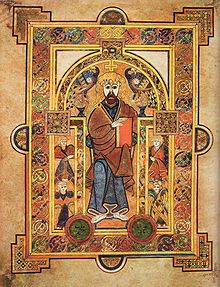
Few truly large stone buildings were attempted between the Constantinian basilicas of the 4th century and the 8th century, but many smaller stone buildings were built during the 6th and 7th centuries. By the beginning of the 8th century, the Carolingian Empire revived the basilica form of architecture. One feature of the renewed basilica was the use of a transept, or the "arms" of a cross-shaped building that are perpendicular to the long nave. Other new features of religious architecture include the crossing tower and a monumental entrance to the church, usually at the west end of the building.
Carolingian art was produced for a small group of figures around the court, and the monasteries and churches they supported. It was dominated by efforts to regain the dignity and classicism of imperial Roman and Byzantine art, but was also influenced by the Insular art of the British Isles. Insular art integrated the energy of Irish Celtic and Anglo-Saxon Germanicstyles of ornament with Mediterranean forms such as the book and established many characteristics of art for the rest of the medieval period. Surviving religious works from the Early Middle Ages are mostly illuminated manuscripts and carved ivories, originally made for metalwork that has been destroyed for its materials. Objects in precious metals were the most prestigious form of art, but nearly all are lost, except for a few crosses like the Cross of Lothair, several reliquaries, and finds such as the Anglo-Saxon burial at Sutton Hoo and the hoards of Gourdon from Merovingian France, Guarrazar from Visigothic Spain and Nagyszentmiklós near Byzantine territory. There are numbers of survivals from the large brooches in fibula or penannular form that were a key piece of personal adornment for elites, including the Irish Tara Brooch. Highly decorated books were mostly Gospel books and these have survived in larger numbers, including the Insular Book of Kells and Book of Lindisfarne, and the imperial Codex Aureus of St. Emmeram, which is one of the few to retain its "treasure binding" of gold encrusted with jewels. Charlemagne's court seems to have been responsible for the crucial acceptance of figurative monumental sculpture in Christian art, and by the end of the period near life-size figures such as the Gero Cross were common in important churches.
Military and technological developments
During the later Roman Empire, the principal military developments had to do with attempts to create an effective cavalry force as well as the continued development of highly specialized types of troops. The creation of cataphract-type soldiers was an important feature of 5th century Roman military developments. The various invading tribes had differing emphasis on types of soldiers - ranging from the primarily infantry Anglo-Saxon invaders of Britain to the Vandals and Visigoths which had a high percentage of cavalry in their armies. During the early invasion period, the stirrup had not been introduced into warfare, which limited the usefulness of cavalry as shock troops, but not to the extent that has generally been proclaimed. It was still possible for cavalry to use shock tactics in battle, especially when the saddle was built up in front and back to allow greater support to the rider. The greatest changes in military affairs during the invasion was the adoption of the Hunnic composite bow in place of the earlier, and weaker, Scythian composite bow. Another development of the invasion period was the increasing use of longswords and the decrease in the use of scale armour and the increasing use of mail amour and lamellar armour.
During the early Carolingian period, a decline in the importance of infantry and light cavalry began, with a corresponding dominance of military events by the elite. The use of militia-type levies of the free population declined over the Carolingian period. Although much of the Carolingian armies were mounted, a large proportion during the early period appear to have been mounted infantry, rather than true cavalry. One exception was Anglo-Saxon England, where the armies were still composed of local levies, known as the fyrd, which were led by the local elites. In military technology, one of the main change was the return of the crossbow, which had previously been known in Roman times, but reappeared as a military weapon during the last part of the Early Middle Ages. Another great change was the introduction of the stirrup, which allowed the more effective use of cavalry as shock troops. One final technological change that had implications beyond the military was the horseshoe, which allowed horses to be used in rocky terrain.
High Middle Ages
Society and economic life
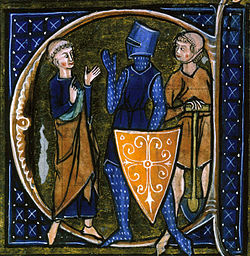
The High Middle Ages saw an expansion of population with rough estimates of the increase from the year 1000 until 1347 indicating that the population of Europe grew from 35 to 80 million. The exact cause or causes of the growth remain unclear; improved agricultural techniques, the decline of slaveholding, a more clement climate and the lack of invasion have all been put forward. As much as 90 percent of the European population remained rural peasants. Many of them were no longer settled in isolated farms but had gathered into small communities, usually known as manors or villages. These peasants were often subject to noble overlords and owed them rents and other services, in a system known as manorialism. There remained a few free peasants throughout this period and beyond.
Other sections of society included the nobility, clergy and townsmen. Nobles, both the titled and simple knights, were the exploiters of the manors and the peasants, although they did not own lands outright, rather they were granted rights to the income from a manor or other lands by an overlord through the system of feudalism. During the 11th and 12th centuries, these lands, or fiefs, came to be considered hereditary and in most areas they were no longer divisible between all the heirs as had been the case in the early medieval period. Instead, most fiefs and lands went to the eldest son. The dominance of the nobility was built upon its control of the land, its military service as heavy cavalry, control of castles, and various immunities from taxes or other impositions. Stone castles began to be constructed in the 9th and 10th centuries in response to the disorders of the time, and allowed inhabitants to take refuge from invaders. Control of castles allowed the nobles to defy kings or other overlords.
The clergy was divided into two types – the secular clergy who lived in the world, and the regular clergy, or those who lived under a religious rule and were usually monks. Most of the regular clergy were drawn from the ranks of the nobility, the same social class that served as the recruiting ground for the upper levels of the secular clergy. The local parish priests were often drawn from the peasant class. Townsmen were in a somewhat unusual position, as they did not fit into the traditional three-fold division of society into nobles, clergy, and peasants. During the 12th and 13th centuries, the ranks of the townsmen expanded greatly as existing towns grew and new population centres were founded.
In Central and Northern Italy and in Flanders, the rise of towns that were, to a degree, self-governing, stimulated economic growth and created an environment for new types of trade associations. Commercial cities on the shores of the Baltic entered into agreements known as the Hanseatic League, and Italian city-states such as Venice, Genoa, and Pisa expanded their trade throughout the Mediterranean. Besides new trading opportunities, agricultural and technological improvements enabled the increase in crop yields, which in turn allowed the trade networks to expand. Rising trade brought new methods of dealing with money, and gold coinage was again minted in Europe, at first in Italy and later in France and other countries. New forms of commercial contracts emerged, allowing risk to be shared among merchants. Accounting methods improved, partly through the use of double-entry bookkeeping; letters of credit also emerged, to allow easy transmission of money through the trading networks.
Political states
The High Middle Ages is the formative period in the history of the Western state. Kings in France, England and Spain consolidated their power, and set up lasting governing institutions. Also new kingdoms like Hungary and Poland, after their conversion to Christianity, became Central-European powers. Hungary owed its settlement to the Magyars, who settled there around 900 under King Árpád (d. around 907) after their invasions during the 9th centuries. The papacy, long attached to an ideology of independence from the secular kings, first asserted its claims to temporal authority over the entire Christian world. The Papal Monarchy reached its apogee in the early 13th century under the pontificate of Innocent III (pope 1198–1216). Northern Crusades and the advance of Christian kingdoms and military orders into previously pagan regions in the Baltic and Finnic northeast brought the forced assimilation of numerous native peoples into European culture.
During the early High Middle Ages, Germany was ruled by the Saxon dynasty, which struggled to control the powerful dukes ruling over territorial duchies tracing back to the Migration period. In 1024, the ruling dynasty changed to the Salian dynasty, who famously clashed with the papacy under Emperor Henry IV (r. 1084–1105) over church appointments. His successors continued to struggle against the papacy as well as the German nobility. After the death of Emperor Henry V (r. 1111–1125) without heirs, a period of instability arose until Frederick I Barbarossa (r. 1155–1190) took the imperial throne. Although Barbarossa managed to rule effectively, the basic problems remained, and his successors continued to struggle into the 13th century. Barbarossa's grandson Frederick II, who was also heir to the throne of Sicily through his mother, clashed repeatedly with the papacy. His court was famous for its scholars and he himself was often accused of heresy. He and his successors faced many difficulties, including the invasion of the Mongols into Europe in the mid 13th century. Mongols first shattered the Kievan Rus principalities and then invaded eastern Europe in 1241, 1259, and 1287.
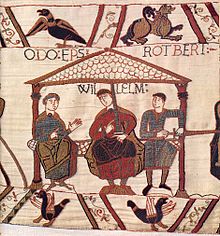
France under the Capetian dynasty, began to slowly expand its power over the nobility, managing to expand out of the Ile de France to exert control over more of the country as the 11th and 12th centuries. They faced a powerful rival in the Dukes of Normandy, who in 1066 under William the Conqueror (duke 1035–1087), conquered England (r. 1066–1087) and created a cross-channel empire that would last, in various forms, throughout the rest of the Middle Ages. Normans not only expanded into England, but also settled in Sicily and southern Italy, when Robert Guiscard (d. 1085) landed there in 1059 and established a duchy that later became a kingdom. Under the Angevin dynasty of King Henry II (r. 1154–1189) and his son King Richard I, the kings of England ruled over England and large sections of France, brought to the family by Henry II's marriage to Eleanor of Aquitaine, heiress to much of southern France. However, Richard's younger brother King John (r. 1199–1216) lost Normandy and the rest of the northern French possessions in 1204 to the French king Philip II Augustus. This led to dissension among the English nobility, while John's financial exactions to pay for his unsuccessful attempts to regain Normandy led in 1215 to Magna Carta, a charter that confirmed the rights and privileges of free men in England. Under Henry III (r. 1216–1272), John's son, further concessions were made to the nobility, and royal power was diminished. The French monarchy continued to make gains against the nobility during the late 12th and 13th centuries, bringing more territories within the kingdom under their personal rule and centralizing the royal administration. Under King Louis IX, royal prestige rose to new heights as Louis served as a mediator for most of Europe.
Crusades
In the 11th century, the Seljuk Turks took over much of the Middle East, taking Persia during the 1040s, Armenia in the 1060s, and capturing Jerusalem in 1070. In 1071, the Turkish army defeated the Byzantine army at the Battle of Manzikert and captured the Byzantine Emperor Romanus IV (r. 1068–1071). This allowed the Turks to invade Asia Minor, which dealt a dangerous blow to the Byzantine Empire by seizing a large part of the empire's population and its economic heartland. Although the Byzantines managed to regroup and recover somewhat, they never regained Asia Minor and were often on the defensive afterwards. The Turks also ran into difficulties, losing control of Jerusalem to the Fatimids of Egypt and suffering from a series of internal civil wars.
The Crusades were intended to seize Jerusalem from Muslim control. The first Crusade was proclaimed by Pope Urban II (pope 1088–1099) at the Council of Clermont in 1095 in response to a request from the Byzantine Emperor Alexios I Komnenos (r. 1081–1118) for aid against further Muslim advances. Urban promised indulgence to anyone who took part. Tens of thousands of people from all levels of society mobilized across Europe, and captured Jerusalem in 1099 during the First Crusade. The crusaders consolidated their conquests in a number of crusader states. During the 12th century and 13th century, there were a series of conflicts between these states and the surrounding Islamic states. Further crusades were called to aid the crusaders, or such as the Third Crusade, called to try to regain Jerusalem, which was captured by Saladin in 1187. In 1203, the Fourth Crusade was diverted from the Holy Land to Constantinople, and captured that city in 1204, setting up a Latin Empire of Constantinople and greatly weakening the Byzantine Empire, which finally recaptured Constantinople in 1261, but the Byzantines never regained their former strength. By 1291 all the crusader states had been either captured or forced from the mainland, with a titular Kingdom of Jerusalem surviving on the island of Cyprus for a number of years after 1291.
Popes called for crusades to take place other than in the Holy Land, with crusades being proclaimed in Spain, southern France, and along the Baltic. The Spanish crusades became fused with the Reconquista, or reconquest, of Spain from the Muslims. Although the Templars and Hospitallers took part in the Spanish crusades, Spanish military religious orders were also founded similar to the Templars and Hospitallers, with most of them becoming part of the two main orders of Calatrava and Santiago by the beginning of the 12th century. Northern Europe also remained outside Christian influence until the 11th century or later; these areas also became crusading venues as part of the Northern Crusades of the 12th through the 14th centuries. These crusades also spawned a military order, the Order of the Sword Brothers. Another order, the Teutonic Knights, although originally founded in the Crusader states, focused much of its activity in the Baltic after 1225, and in 1309 moved its headquarters to Marienburg in Prussia.
Intellectual life
During the 11th century, developments in philosophy and theology led to increased intellectual activity. There was debate between the realists and the nominalists over the concept of " universals". Philosophical discourse was stimulated by the rediscovery of Aristotle and his emphasis on empiricism and rationalism. Scholars such as Peter Abelard (d. 1142) and Peter Lombard (d. 1164) introduced Aristotelian logic into theology. The late 11th and early 12th century also saw the rise of cathedral schools throughout western Europe, signaling the shift of learning from monasteries to cathedrals and towns. Cathedral schools were then in turn replaced in the late 11th century by the universities established in major European cities. Philosophy and theology fused in scholasticism, an attempt by 12th and 13th-century scholars to reconcile Christian theology with itself, which eventually resulted in a system of thought that tried to employ a systemic approach to truth and reason. This culminated in the thought of Thomas Aquinas (d. 1274), who wrote the Summa Theologica, or Summary of Theology.
Besides the universities, royal and noble courts saw the development of chivalry and the ethos of courtly love. This culture was expressed in the vernacular languages rather than Latin, and comprised poems, stories, legends and popular songs spread by troubadors, or wandering minstrels. Often the stories were written down in the chansons de geste, or "songs of great deeds", such as The Song of Roland or The Song of Hildebrand. Besides these products of chivalry, other writers composed histories, both secular and religious. Geoffrey of Monmouth (d. around 1155) composed his Historia Regum Britanniae, which was a collection of stories and legends about Arthur. Other works were more clearly history, such as Otto von Freising's (d. 1158) Gesta Friderici Imperatoris detailing the deeds of Emperor Frederick I or William of Malmesbury's (d. around 1143) Gesta Regum on the kings of England.
Legal studies also advanced during the 12th century. Both secular law and canon law, or ecclesiastical law, were studied in the High Middle Ages. Secular law, or Roman law, was advanced greatly by the discovery of the corpus iuris civilis in the 11th century, and by 1100 Roman law was being taught at Bologna. This led to the recording and standardization of legal codes throughout western Europe. Canon law was also studied, and around 1140 a monk named Gratian ( flourished 12th century), a teacher at Bologna, wrote what became the standard text of canon law – the Decretum.
Among the results of the Greek and Islamic influence on this period in European history was the replacement of Roman numerals with the decimal positional number system and the invention of algebra, which allowed more advanced mathematics. Astronomy also advanced, with the translation of Ptolomey's Almagest from Greek into Latin in the late 12th century. Medicine was also studied, especially in southern Italy, where Islamic medicine influenced the school at Salerno.
Technology and military
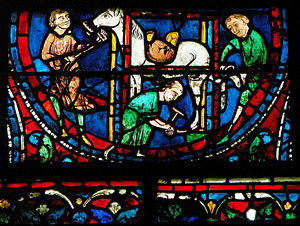
In the 12th and 13th centuries, Europe saw a number of innovations in methods of production and economic growth. Major technological advances included the invention of the windmill, the first mechanical clocks, the first investigations of optics and the creation of crude lenses, the manufacture of distilled spirits and the use of the astrolabe. Glassmaking advanced with the development of a process that allowed the creation of transparent glass in the early 13th century. Transparent glass made possible the science of optics by Roger Bacon (d. 1294), who is credited with the invention of eyeglasses.
A major agricultural innovation was the development of a 3-field rotation system for planting crops. The development of the heavy plow allowed heavier soils to be farmed more efficiently, an advance that was helped along by the spread of the horse collar, which led to the use of draught horses in place of oxen. Horses are faster than oxen and require less pasture, factors which aided the utilization of the 3-field system.
The development of cathedrals and castles advanced building technology, leading to the development of large stone buildings. Ancillary structures included new town halls, houses, bridges, and tithe barns. Shipbuilding also improved, with the use of the rib and plank method rather than the old Roman system of mortice and tenon. Other improvements to ships included the use of lateen sails and the stern-post rudder, both of which increased the speed at which ships could be sailed.
Crossbows, which had been known in Late Antiquity, increased in use, partly because of the increase in siege warfare in the 10th and 11th centuries. Military affairs saw an increase in the use of infantry with specialized roles during this period. Besides the still dominant heavy cavalry, armies often included both mounted and infantry crossbowmen, as well as sappers and engineers. The increasing use of crossbows during the 12th and 13th centuries led to the use of closed-face helmets, heavy body armour, as well as horse armour. Gunpowder was known in Europe by the mid-13th century with a recorded use in European warfare by the English against the Scots in 1304, although it was merely used as an explosive and not as a weapon. Cannon were being used for sieges in the 1320s, and hand held guns were known and in use by the 1360s.
Architecture, art, and music
In the 10th century the establishment of churches and monasteries lead to the development of stone architecture that elaborated vernacular Roman forms, which led to it being later named Romanesque. Where available, Roman brick and stone buildings were recycled for their materials. From the fairly tentative beginnings known as the First Romanesque, the style flourished and spread across Europe in a remarkably homogeneous form. Right before 1000 there was a great wave of building stone churches all over Europe. Besides architecture, according to art historian C. R. Dodwell, "virtually all the churches in the West were decorated with wall-paintings", of which few survive. Romanesque architecture features massive stone walls, openings topped by semi-circular arches, small windows, and, particularly in France, arched stone vaults. The large portal with coloured sculpture in high relief became a central feature of façades, especially in France, and the capitals of columns were often carved with narrative scenes of imaginative monsters and animals. The distinctive European form of the castle was developed, and became crucial to politics and warfare.
Romanesque art, especially metalwork, was at its most sophisticated in Mosan art, where distinct artistic personalities such as Nicholas of Verdun (d. 1205) become apparent, and an almost classical style is seen in works like a font at Liège, contrasting with the writhing animals of the exactly contemporary Gloucester Candlestick. Large illuminated bibles and psalters were the typical forms of luxury manuscripts, and wall-painting flourished in churches, often following a scheme with a Last Judgement on the west wall, a Christ in Majesty at the east end, and narrative biblical scenes down the nave, or in the best surviving example, at Saint-Savin-sur-Gartempe, on the barrel-vaulted roof.
From the early 12th century, French builders developed the Gothic style, marked by the use of rib vaults, pointed arches, flying buttresses, and large stained glass windows. The Gothic style was mainly used in churches and cathedrals, and continued in use until the 16th century in much of Europe. Classic examples of Gothic architecture include Chartres Cathedral and Reims Cathedral in France as well as Salisbury Cathedral in England. Stained glass became a crucial element in the design of churches, which continued to use extensive wall-paintings, now almost all lost.
During this period the practice of manuscript illumination gradually passed from monasteries to lay workshops, so that according to Janetta Benton "by 1300 most monks bought their books in shops", and the book of hours developed as a form of devotional book for lay-people. Metalwork continued to be the most prestigious form of art, with Limoges enamel an option for reliquaries and crosses. In Italy the innovations of Cimabue, followed by the Trecento masters Giotto (d. 1337) and Duccio (d. around 1318), greatly increased the sophistication and status of panel painting and fresco. In the 12th century secular art increased with the growing prosperity and many carved ivory objects such as gaming-pieces, combs, and small religious figures survive.
Church life
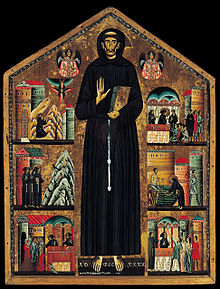
Monastic reform became an important issue during the 11th century, as elites began to worry that monks were not adhering to the rules binding them to a stricy religious life. Cluny Abbey, founded in the Mâcon region of France in 909, was established as part of the Cluniac Reforms, a larger movement of monastic reform in response to this fear. Cluny quickly established a reputation for austerity and rigour and sought to maintain a high quality of spiritual life by electing its own abbot without interference from laymen, thus maintaining economic and political independence from local lords and placing itself under the protection of the papacy.
Monastic reform inspired change in the secular church. The ideals that it was based upon were brought to the papacy by Pope Leo IX (pope 1049–1054), and provided the ideology of the clerical independence that led to the Investiture Controversy in the late 11th century. This involved Pope Gregory VII (pope 1073–1085) and Emperor Henry IV, who initially clashed over episcopal appointments, a dispute that turned into a battle over the ideas of investiture, clerical marriage, and simony. The emperor saw the protection of the Church as one of his responsibilities as well as wanting to preserve the right to appoint his own choices as bishops within his lands, but the papacy insisted on the Church's independence from secular lords These issues themselves remained unresolved after the compromise of 1122 known as the Concordat of Worms. The conflict represents a significant stage in the creation of a papal monarchy separate from and equal to lay authorities. It also had the permanent consequence of empowering German princes at the expense of the German emperors.
The High Middle Ages was a period of great religious movements. Besides the Crusades and monastic reforms, people sought to participate in new forms of religious life. New monastic orders were founded, including the Carthusians and the Cistercians. The Cistercians, especially, expanded rapidly in their early years under the guidance of Bernard of Clairvaux. These new orders were formed in response to the feeling of the laity that Benedictine monasticism no longer met the needs of the laymen. Laymen and those wishing to enter the religious life wanted to return to the simpler hermetical monasticism of early Christianity or to live an Apostolic life. Besides new monastic orders, religious pilgrimages were encouraged, with old pilgrimage sites such as Rome, Jerusalem, and Compostela seeing renewed visitation and new sites such as Monte Gargano and Bari rising to prominence.
In the 13th century, mendicant orders – the Franciscans and the Dominicans – who swore vows of poverty and earned their living by begging, were approved by the papacy. Besides the recognized orders, other religious groups such as the Waldensians and the Humiliati attempted to return to the life of early Christianity in the middle 12th and early 13th centuries, but they were condemned as heretical by the papacy. Others joined the Cathars, another heretical movement condemned by the papacy. In 1209, a crusade was preached against the Cathars, the Albigensian Crusade, which in combination with the medieval Inquisition, finally eliminated them.
Late Middle Ages
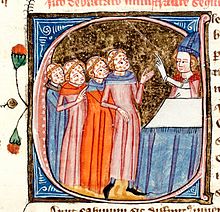
War, famine and plague
The first years of the 14th century were marked by a number of famines, culminating in the Great Famine of 1315–1317. The causes of the Great Famine were not just related to the ongoing climatic change that was taking place, a slow transition from the Medieval Warm Period to the Little Ice Age, but also had causes in overspecialization in single crops, which left the population vulnerable when bad weather caused crop failures. Other troubles included an economic downturn and the aforementioned climate change – which resulted in the average annual temperature for Europe declining during the 14th century. But knowledge of Asia and the trade routes to China expanded during the period, through the invasions of the Mongols and the travels of Marco Polo.
These troubles were followed in 1347 by the Black Death, a disease that spread throughout Europe in the years 1348, 1349, and 1350. The death toll was probably about 35 million people in total in Europe, about one-third of the population. Towns were especially hard-hit because of the crowded conditions. Large areas of land were left sparsely inhabited, and in some places fields were left unworked. Because of the sudden decline in available labourers, the price of wages rose as landlords sought to entice workers to their fields, but the lower rents were balanced out by the lower demand for food, which cut into agricultural income. Urban workers also felt that they had a right to greater earnings, and popular uprisings broke out across Europe. Among the uprisings were the jacquerie in France, the Peasants' Revolt in England, and revolts in the cities of Florence in Italy and Ghent and Bruges in Flanders. The trauma of the plague led to an increased piety throughout Europe, which manifested itself in the foundation of new charities, the extreme self-mortification of the flagellants, and the scapegoating of the Jews. Conditions were further unsettled by the return of the plague throughout the rest of the 14th century. It continued to strike Europe throughout the rest of the Middle Ages.
State resurgence
The Late Middle Ages also witnessed the rise of strong, royalty-based nation-states throughout Europe, particularly in England, France, and the Christian kingdoms of the Iberian Peninsula – Aragon, Castile, and Portugal. The long conflicts of the later Middle Ages strengthened royal control over the kingdoms, even though they were extremely hard on the peasantry. Kings profited from warfare by gaining land and extended royal legislation throughout their kingdoms. Paying for the wars required that the methods of taxation become more efficient and the rate of taxation often increased. The requirement to obtain the consent of those taxed meant that representative bodies such as the English Parliament or the French Estates General gained some power and new authority.
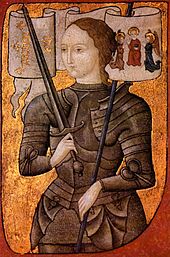
Throughout the 14th century, French kings sought to expand their influence throughout the kingdom at the expense of the territorial holdings of the nobility. This ran into difficulties when they attempted to confiscate the holdings of the English kings in southern France, leading to the Hundred Years' War, which lasted until 1453. At first, the English under King Edward III and his son Edward, the Black Prince, won the battles of Crécy and Poitiers, captured the city of Calais and won control of much of France. The stresses of this war almost caused the disintegration of the French kingdom during the early years of the war. In the early 15th century, France once more teetered on the brink of dissolving, but in the late 1420s military successes led by Joan of Arc (d. 1431) led to the eventual victory of the French kings over the English with the capture of the last of the English possessions in southern France in 1453. The price was high, as the population of France at the end of the Wars was likely half what it had been prior to the start of the conflict. Conversely, the Wars had a positive effect on English national identity, doing much to fuse the various local identities into a national English ideal. The conflict with the French also helped create a national culture in England that was separate from French culture, which had been the dominant cultural influence in England prior to the outbreak of the Hundred Years' War. The early Hundred Years' War also saw the dominance of the English longbow, and the appearance of cannon on the battlefield at Crécy in 1346.
In modern-day Germany, the Empire continued, but the elective nature of the imperial crown meant that there was no strong dynasty around which a strong state could form. Further east, the kingdoms of Poland, Hungary, and Bohemia grew into powerful kingdoms. The Iberian Peninsula kingdoms continued to gain land from the Muslim kingdoms of the peninsula, with Portugal concentrating on expanding overseas during the 15th century while the other kingdoms were riven by difficulties over the royal succession and other concerns throughout the 15th century. England, after losing the Hundred Years' War, went on to suffer a long civil war known as the Wars of the Roses, which lasted into the 1490s, after Henry Tudor consolidated his hold on England from his victory over King Richard III at Bosworth in 1485. Scandinavia went through a period of union under the Union of Kalmar in the late 14th and early 15th century, but dissolved once more after the death of Queen Margaret I of Denmark (r. in Denmark 1353–1412), who had united Norway, Denmark, and Sweden. The major power around the Baltic Sea was the city states of the Hanseatic League, a commercial confederation which traded from western Europe to Russia. Scotland emerged from English domination under King Robert the Bruce (r. 1306–1329), who secured papal recognition of his kingship in 1328.
Collapse of Byzantium
Although the Palaeologi emperors managed to recapture Constantinople from the western Europeans in 1261, they were never able to regain control of much of the former imperial lands. They usually controlled only a small section of the Balkan Peninsula near Constantinople, the city itself, and some coastal lands on the Black Sea and around the Aegean Sea. The former Byzantine lands in the Balkans were divided between the new kingdoms of Serbia and Bulgaria and the city-state of Venice. The power of the Byzantine emperors was threatened by a new Turkish tribe, the Ottomans, who established themselves in Anatolia in the 13th century and steadily expanded throughout the 14th century. The Ottomans expanded into Europe, reducing Bulgaria to a vassal state by 1366 and taking over Serbia after the Serbian defeat at the Battle of Kosovo in 1389. Western Europeans rallied to the plight of the Christians in the Balkans and declared a new Crusade in 1396, and a great army was sent to the Balkans which met defeat at the Battle of Nicopolis. Constantinople finally was captured by the Ottomans in 1453.
Controversy within the Church
The troubled 14th century saw both the Avignon Papacy of 1305–1378, also called the "Babylonian Captivity of the Papacy" (a reference to the Babylonian Captivity of the Jews), and then the Great Schism that lasted from 1378 to 1418, when there were two, then later three, rival popes, each supported by a number of states. In the early years of the 15th century, after a century of turmoil, ecclesiastical officials convened in Constance in 1414, and in 1415 the council deposed one of the rival popes, leaving only two claimants. Further depositions followed, and in November 1417 the council elected Martin V (pope 1417–1431) as pope.
Besides the schism, the western church was riven by theological controversies, some of which turned into heresies. John Wyclif (d. 1384), an English theologian, was condemned as a heretic in 1415 for teaching that the laity should have access to the text of the Bible as well as holding views on the Eucharist that were contrary to church doctrine. Wyclif's teachings influenced two of the major heretical movements of the later Middle Ages – Lollardry in England and Hussitism in Bohemia. The Bohemians were also influenced by the teaching of Jan Hus, who was eventually burned at the stake in 1415 after being condemned as a heretic by the Council of Constance. The Hussite church, although subject to a crusade being called against it, survived past the end of the Middle Ages.
The papacy refined the concept of transubstantiation further in the Late Middle Ages, stating that the clergy alone was allowed to partake of the wine in the Eucharist. This further distanced the secular laity from the clergy. The laity continued the practices of pilgrimages, veneration of relics, and the belief in power of the Devil. Mystics such as Meister Eckhart (d. 1327) or Thomas à Kempis (d. 1471) wrote works that taught the laity to focus on their inner spiritual life, something that contributed to the Protestant Reformation. Besides mysticism, belief in witches and witchcraft became widespread, and by the late 15th century the Church had begun to lend credence to populist fears of witchcraft with its condemnation of witches in 1484 and the publication of the Malleus Maleficarum, the most popular handbook for witchhunters, in 1486.
Scholars, intellectuals, and exploration
The Later Middle Ages saw a reaction against scholasticism led by John Duns Scotus (d. 1308) and William of Ockham (d. around 1348), both of whom objected to the application of reason to faith. Their efforts, along with others, led to an undermining of the prevailing Platonic idea of "universals". Ockham's insistence that reason operates independently of faith allowed science to be separated from theology and philosophy. Legal studies were marked by the steady advance of Roman law into areas of jurisprudence previously governed by customary law. The one exception to this trend was England, where the common law remained pre-eminent. Countries also codified their laws, with legal codes being promulgated in countries as far apart as Castile, Poland, and Lithuania.
Education remained mostly focused on the training of future clergy. The basic learning of the letters and numbers remained the province of the family or a village priest, but the secondary subjects of the trivium – grammar, rhetoric, logic – were studied in either cathedral schools or in schools provided by cities. Commercial secondary schools spread also, with some towns in Italy having more than one such enterprise. Universities also spread throughout Europe in the 14th and 15th centuries. The rise of vernacular literature increased in pace, with Dante, Petrarch and Giovanni Boccaccio in 14th century Italy, Geoffrey Chaucer and William Langland in England, and François Villon and Christine de Pizan in France. Much literature remained religious in character, but although much of this continued to be written in Latin, a new demand developed for saints' lives and other devotional tracts in the vernacular languages. This was fed by the growth of the devotio moderna movement, most prominently in the formation of the Brethren of the Common Life, but also in the works of German mystics such as Meister Eckhart and Johannes Tauler. Theatre also developed in the guise of miracle plays put on by the Church. At the end of the period, the development of the printing press around 1450 led to the establishment of publishing houses throughout Europe by 1500.
Beginning in the early 15th century, the countries of the Iberian peninsula began sponsoring exploration past the boundaries of Europe. Prince Henry the Navigator of Portugal (d. 1460), sent expeditions that discovered the Canary Islands, the Azores, and Cape Verde during his lifetime. After his death, exploration continued, with Bartholomew Diaz (d. 1500) going around the Cape of Good Hope in 1486 and Vasco de Gama (d. 1524) sailing around Africa to India in 1498. The combined Spanish monarchies of Castile and Aragon sponsored Christopher Columbus' (d. 1506) voyage of exploration in 1492 that discovered the Americas. The English crown under King Henry VII (r. 1485–1509) sponsored the voyage of John Cabot (d. 1498) in 1497, which landed on Cape Breton Island.
Technological and military developments
One of the major developments in the military sphere during the Late Middle Ages was the increasing use of infantry and light cavalry. The English also employed longbowmen, but other countries were unable to create similar forces that enjoyed the same military success. Armour continued to advance, spurred on by the increasing power of crossbows, and plate armour was developed to help protect against the threat from crossbows as well as the hand-held guns that were developed. Pole-arms reached new prominence with the development of the Flemish and Swiss infantry armed with pikes and other long spears.
Late medieval art and architecture
The Late Middle Ages in Europe as a whole correspond to the Trecento and Early Renaissance in Italy, while Northern Europe and Spain continued to use Gothic styles, increasingly elaborate in the 15th century, until almost the end of the period. International Gothic was a courtly style that reached much of Europe in the decades around 1400, producing masterpieces such as the Très Riches Heures du Duc de Berry. All over Europe secular art continued to increase in quantity and quality, and in the 15th century the mercantile classes of Italy and Flanders became important patrons, commissioning small portraits of themselves in oils as well as a growing range of luxury items such as jewellery, ivory caskets, cassone chests and maiolica pottery. These objects also included the Hispano-Moresque ware produced by mostly Mudéjar potters in Spain. Although royalty owned huge collections of plate, little survives except for the Royal Gold Cup. Italian silk manufacture developed, so that Western churches and elites no longer needed to rely on imports from Byzantium or the Islamic world. In France and Flanders tapestry weaving of sets like The Lady and the Unicorn became a major luxury industry.
The large external sculptural schemes of Early Gothic churches gave way to more sculpture inside the building, as tombs became more elaborate and other features such as pulpits were sometimes lavishly carved, as in the Pulpit by Giovanni Pisano in Sant'Andrea. Painted or carved wooden relief altarpieces became common, especially as churches created many side-chapels. Early Netherlandish painting with artists such as Jan van Eyck (d. 1441) and Rogier van der Weyden (d. 1464) rivalled that of Italy, as did northern illuminated manuscripts, which in the 15th century began to be collected on a large scale by secular elites, who also commissioned secular books, especially histories. From about 1450 printed books rapidly became popular, though still expensive, and there were around 30,000 different editions of incunabula printed by 1500, and by then illuminated manuscripts were only commissioned by royalty and a few others. Very small woodcuts, nearly all religious, were affordable even by peasants in parts of Northern Europe from the middle of the 15th century, with more expensive engravings supplying a wealthier market with a variety of images.
Modern image
The medieval period is frequently caricatured as supposedly a "time of ignorance and superstition" which placed "the word of religious authorities over personal experience and rational activity." This is a legacy from both the Renaissance and Enlightenment, when scholars contrasted their intellectual cultures with the medieval period, with a negative attitude toward the Middle Ages. Renaissance scholars saw the Classical world as a time of high culture and civilization, and saw the Middle Ages as a decline from that culture. Enlightenment scholars saw reason as superior to faith, and thus viewed the Middle Ages as a time of ignorance and superstition.
Others argue that reason was generally held in high regard during the Middle Ages. Science historian Edward Grant writes, "If revolutionary rational thoughts were expressed [in the 18th century], they were only made possible because of the long medieval tradition that established the use of reason as one of the most important of human activities". Also, contrary to common belief, David Lindberg writes, "the late medieval scholar rarely experienced the coercive power of the church and would have regarded himself as free (particularly in the natural sciences) to follow reason and observation wherever they led".
The caricature of the period is also reflected in a number of more specific notions. One common misconception was first propagated in the 19th century and is still very common is that all people in the Middle Ages believed that the Earth was flat. This is untrue, as lecturers in the medieval universities commonly argued that evidence showed the Earth was a sphere. Lindberg and Ronald Numbers, another scholar of the period, state that there "was scarcely a Christian scholar of the Middle Ages who did not acknowledge [Earth's] sphericity and even know its approximate circumference". Other misconceptions such as "the Church prohibited autopsies and dissections during the Middle Ages", "the rise of Christianity killed off ancient science", or "the medieval Christian church suppressed the growth of natural philosophy", are all cited by Numbers as examples of widely popular myths that still pass as historical truth, although they are not supported by current historical research.

